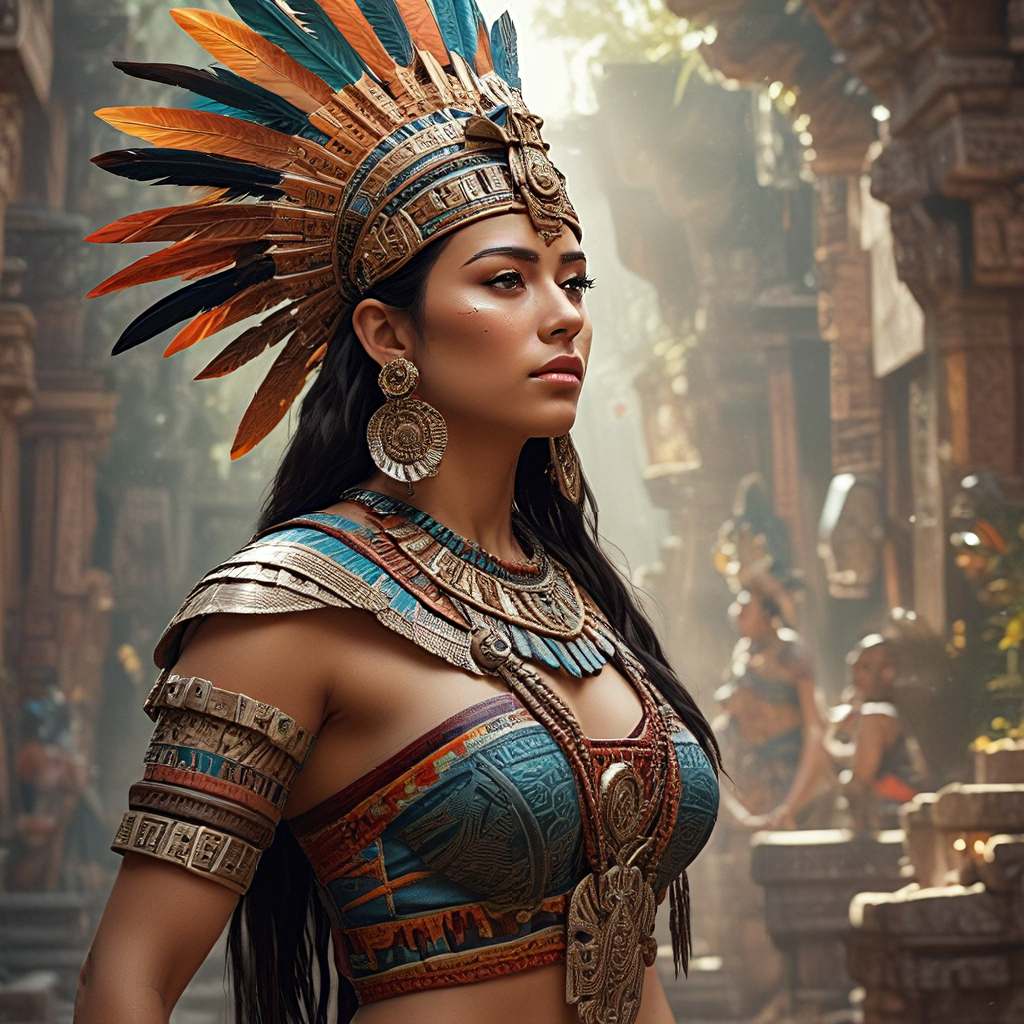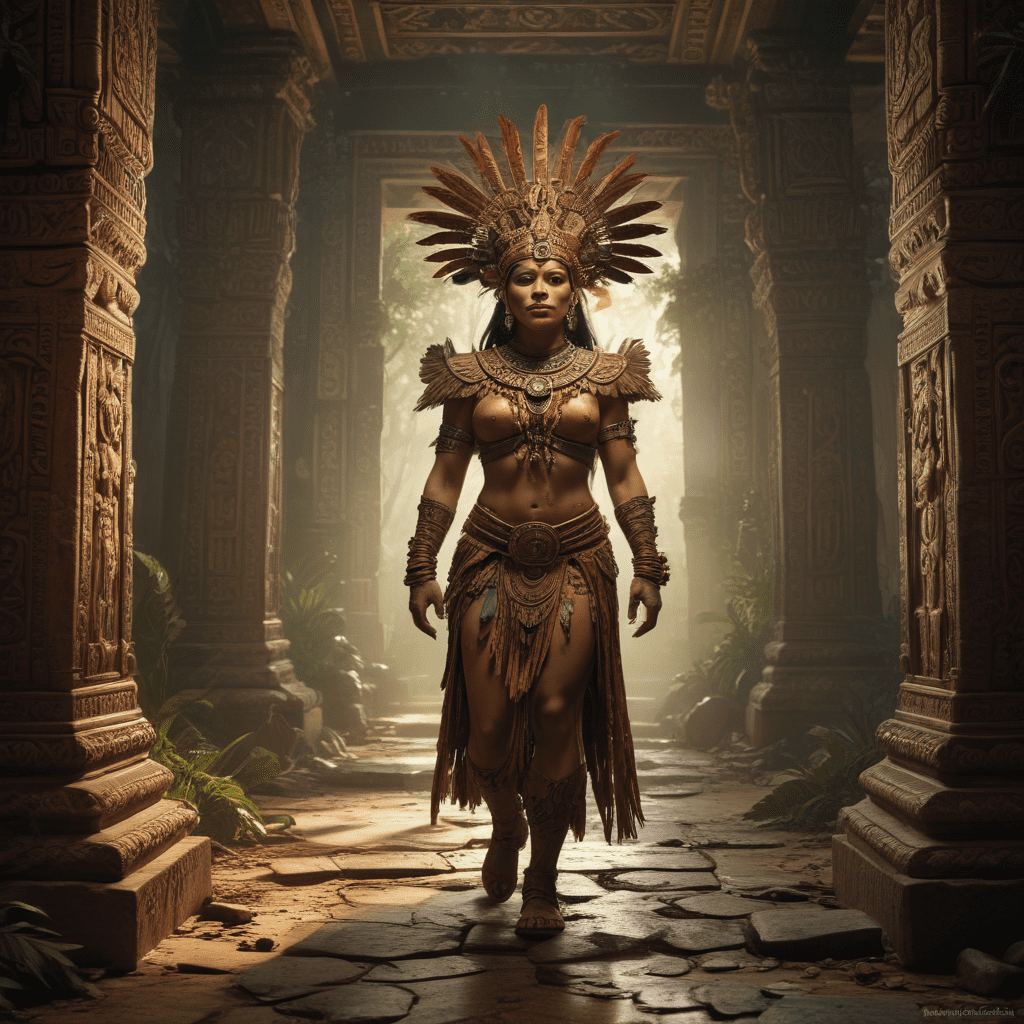The Role of Women in Aztec Mythology: An Overview
The Aztec civilization, renowned for its complex social structure and intricate religious beliefs, placed a significant importance on the role of women in their mythology. Aztec women were not only seen as essential figures in domestic life but also held a revered position within their spiritual realm. Their deities, rituals, and stories profoundly shaped the understanding of womanhood and its connection to the divine in Aztec society. Examining these myths and legends reveals a fascinating and multifaceted picture of women's impact on the cultural fabric of the Aztecs.
The Creation Myth and the Importance of Women
At the heart of Aztec mythology lies the creation myth, which highlights the essential role played by women in bringing forth life and order to the world. The story tells how the Earth was formed from the sacrifice of a primordial being, Coatlicue. She was a powerful goddess and a mother figure who gave birth to the moon, stars, and eventually, Huitzilopochtli, the god of war and the sun. This origin story places women at the center of creation, establishing a deep connection between them and the forces of life and fertility.
Cihuacoatl: The Goddess of Childbirth and War
Cihuacoatl is a prominent figure in Aztec mythology, embodying the dual nature of womanhood. This powerful goddess is known as the "snake woman," a name that reflects her association with childbirth, motherhood, and the underworld. She was believed to guide souls through the afterlife and aid women in labor, but also represented the harsh realities of childbirth and the potential for death during labor. Her association with war and death stems from the belief that women who died in childbirth were transformed into Cihuacoatl, joining her in the underworld.
Tonantzin: The Mother Goddess and Her Connection to Fertility
Tonantzin, known as the "our mother," is considered a central figure in Aztec religion. She is the mother goddess, representing the life-giving power of nature and the nurturing nature of motherhood. Tonantzin was associated with the cycles of nature, particularly with the earth, the moon, and the stars, all of which influenced fertility. Her influence extended to agriculture, and she was worshipped as the protector of crops and the goddess of harvest. Her sacred sites were often located on mountains and hills, emphasizing her connection to the natural world.
The Triple Goddess: Coatlicue, Teteoinnan and Toci
In Aztec mythology, several goddesses are intertwined, forming a powerful trio known as the "Triple Goddess." This group consists of Coatlicue, Teteoinnan, and Toci, representing different aspects of female power and motherhood. Coatlicue, as described earlier, is the mother of the gods, symbolizing creation and primal energy. Teteoinnan, "Our Mother," is associated with motherhood and childbirth, mirroring the nurturing aspects of Tonantzin. Toci, known as the "grandmother of the gods," represents the wisdom and experience of age, but also the harsh reality of death. This trinity reveals the complex and multifaceted role of women in Aztec mythology, encompassing creation, nurturing, and ultimately, the cycle of life and death.
The Role of Women in Aztec Rituals and Ceremonies
Aztec women played a vital role in various rituals and ceremonies, reflecting their deep connection to the spiritual realm. They participated in many important celebrations, often taking on specific roles that highlighted their unique position within the society.
One notable example was the "Tociztli" festival, dedicated to the goddess Toci, who represented motherhood, fertility, and death. This festival featured elaborate rituals involving women, particularly those who had recently given birth, who played a central role in honoring the goddess. Their participation was crucial as they symbolized the life-giving power associated with Toci.
Another significant ritual was the "Ceremony of the New Fire," where women were entrusted with the task of preparing the sacred fire. This ritual involved selecting a virgin woman, often called the "Fire Woman," who was considered a representation of the goddess Tonantzin. The Fire Woman held the honor of lighting the new fire, symbolizing the renewal of life and the cyclical nature of existence.
Beyond these specific examples, Aztec women actively participated in various other ceremonies, including those dedicated to agriculture, healing, and the cycle of the moon. Their presence and participation in these rituals reinforced their importance in maintaining balance and harmony within the Aztec world.
Women as Priestesses and Shamans
While the Aztec priesthood was predominantly male, women also held significant roles as priestesses and shamans. These women were highly respected for their spiritual knowledge and abilities to communicate with the divine. They were often entrusted with the care of sacred objects and the performance of specific rituals.
The priestess of Cihuacoatl, for instance, played a crucial role in supporting women in childbirth and guiding their souls through the afterlife. They held a special connection to the underworld and were believed to possess knowledge of healing and spiritual guidance.
Furthermore, many women served as shamans, possessing the ability to communicate with spirits and cure diseases. They were skilled in herbal medicine and used their knowledge to heal the sick and protect the community from misfortune.
These examples demonstrate that women held positions of power and influence within the Aztec spiritual realm, even though their roles differed from men. Their knowledge, expertise, and spiritual abilities were essential to the maintenance of Aztec society and the well-being of its people.
The Influence of Female Deities on Aztec Society
The presence of powerful goddesses in Aztec mythology deeply influenced the values and beliefs of Aztec society. The female deities embody a multifaceted understanding of womanhood, encompassing creation, fertility, healing, and even death. These goddesses fostered a sense of respect and reverence for women within the community.
The influence of goddesses like Coatlicue, Tonantzin, and Cihuacoatl extended beyond the spiritual realm, shaping various aspects of daily life. Their association with agriculture and fertility, for example, influenced the practices of farming and the importance placed on ensuring abundant harvests.
The veneration of these goddesses also helped to foster a deep appreciation for motherhood and the nurturing qualities associated with women. This appreciation manifested in how women were valued as educators, caregivers, and preservers of cultural knowledge and traditions.
Interpretations of Women’s Roles in Aztec Mythology
Understanding the role of women in Aztec mythology is a complex and multifaceted endeavor. There are various interpretations and perspectives on their status and influence within the society. Some scholars have argued that Aztec women occupied a subordinate position compared to men, pointing to their limited participation in political and military spheres.
However, other scholars emphasize the significant roles women played in religious practices, domestic life, and spiritual guidance. They highlight the presence of powerful goddesses and the unique roles women occupied as priestesses, shamans, and healers.
Ultimately, the understanding of women's roles in Aztec mythology remains contested. It is crucial to consider the diverse perspectives and avoid generalizations that may misrepresent the complex realities of Aztec society.
The Impact of Colonialism on the Understanding of Aztec Mythology
The arrival of the Spanish conquistadors in the 16th century had a profound impact on the understanding of Aztec mythology, leading to distorted interpretations and biases. The Spanish, with their own religious beliefs and cultural values, actively sought to suppress and eradicate Aztec practices and beliefs.
This effort resulted in the destruction of many Aztec texts and the suppression of oral traditions. As a consequence, a substantial portion of the original Aztec understanding of mythology and women's roles within it was lost, making it difficult to gain a complete and accurate picture.
The colonial lens through which Aztec mythology was reconstructed often presented women as passive figures or victims of the patriarchal Aztec system. This interpretation, shaped by colonial biases, fails to fully acknowledge the multifaceted and influential roles women played in Aztec society.
FAQ
1. Were Aztec women allowed to own property?
Yes, Aztec women could own property, including land and goods. Some women even owned businesses and managed their own finances.
2. Could Aztec women divorce?
Divorce was allowed in Aztec society, but it was generally considered a last resort. The decision to divorce required the approval of both the woman and her husband, as well as the intervention of community elders.
3. Did all Aztec women have to marry?
While marriage was considered the ideal for most women, it was not always compulsory. Some women chose to remain unmarried or dedicated themselves to religious service.
4. Were Aztec women allowed to participate in warfare?
While Aztec women were not directly involved in warfare, they played a crucial role in supporting the warriors. They cooked, mended clothes, and prepared sacrifices for the gods, contributing to the success of Aztec military campaigns.
5. What is the significance of the goddess Cihuacoatl?
Cihuacoatl is an important figure in Aztec mythology as she embodies the power and duality of womanhood. She is associated with childbirth, motherhood, and the afterlife, guiding souls through the transition from life to death.
6. What were the primary roles of women in Aztec society?
Aztec women played various essential roles in society, including being mothers, caregivers, educators, weavers, farmers, and religious figures. They contributed to the economic, social, and spiritual well-being of the Aztec community.



